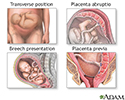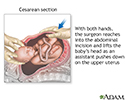After a C-section - in the hospital
Cesarean section - in the hospital; Postpartum - cesareanMost women will remain in the hospital for 2 to 3 days after a cesarean birth (C-section). Take advantage of the time to bond with your new baby, get some rest, and receive some help with breastfeeding and caring for your baby.
C-section
A C-section is the delivery of a baby by making an opening in the mother's lower belly area. It is also called a cesarean delivery.

What to Expect after a C-section
Right after surgery you may feel:
- Groggy from any medicines you received
- Nausea for the first day or so
- Itchy, if you received narcotics in your epidural
You will be brought to a recovery area right after surgery, where a nurse will:
- Monitor your blood pressure, heart rate, and the amount of your vaginal bleeding
- Check to make sure your uterus is becoming firmer
- Bring you to a hospital room once you are stable, where you will spend the next few days
After the excitement of finally delivering and holding your baby, you may notice just how tired you are.
Your belly will be painful at first, but it will improve a lot over 1 to 2 days.
You may be required to wear compression stockings on your legs to improve blood flow and decrease the risk of blood clots. You will be asked to blow air into a device for the initial 24 hours to improve lung function and breathing.
Some women feel sadness or an emotional letdown after delivery. These feelings are not uncommon. Do not feel ashamed. Talk with your health care providers and partner.
Seeing and Caring for Your Baby
Breastfeeding can often begin right after surgery. The nurses can help you find the right position. Numbness from your anesthetic can limit your movement for a while, and pain in your cut (incision) can make it a little harder to become comfortable, but do not give up. The nurses can show you how to hold your baby so there is no pressure on your cut (incision) or abdomen.
Holding and caring for your new infant is exciting, making up for the long journey of your pregnancy and the pain and discomfort of labor. Nurses and breastfeeding specialists are available to answer questions and help you.
Also take advantage of the babysitting and room service the hospital provides for you. You are going home to both the joys of being a mother and the demands of caring for a newborn infant.
Activity
Between feeling exhausted after labor and managing the pain from the surgery, getting out of bed may seem like too big of a task.
But getting out of bed at least once or twice a day at first can help speed your recovery. It also decreases your chance of having blood clots and helps your bowels move.
Make sure someone is around to help you in case you get dizzy or weak. Plan on taking your walks soon after you have received some pain medicine.
Contractions and Bleeding
Once you deliver, the heavy contractions are over. But your uterus still needs to contract to shrink back to its normal size and prevent heavy bleeding. Breastfeeding also helps your uterus contract. These contractions may be somewhat painful, but they are important.
As your uterus becomes firmer and smaller, you are less likely to have heavy bleeding. Blood flow should gradually become slower during your first day. You may notice a few smaller clots passing when the nurse presses on your uterus to check it.
Pain Relief
Your epidural, or spinal, catheter can also be used for pain relief after surgery. It may be left in for up to 24 hours after delivery.
Pain relief after surgery
Pain that occurs after surgery is an important concern. Before your surgery, you and your surgeon may have discussed how much pain you should expect...

If you did not have an epidural, you may receive pain medicines directly into your veins through an intravenous line (IV) after surgery.
- This line runs through a pump that will be set to give you a certain amount of pain medicine.
- Often, you can push a button to give yourself more pain relief when you need it.
- This is called patient controlled analgesia (PCA).
You will then be switched to pain pills that you take by mouth, or you may receive shots of medicine. It is OK to ask for pain medicine when you need it.
What Else?
You will have a urinary (Foley) catheter in place right after surgery, but this will be removed on the first day after surgery.
You will have a bandage on your belly to protect the cut (incision). A nurse may monitor the bandage for signs of drainage or bleeding. The area around your cut may be sore, numb, or both. Sutures or staples will usually be removed at a follow-up office visit with your provider.
At first you may be asked to only eat ice chips or take sips of water, at least until your provider is certain you are not likely to have very heavy bleeding. Most likely, you will be able to eat a light diet 8 hours after your C-section.
References
Berghella V, Mackeen AD, Jauniaux ERM. Cesarean delivery. In: Landon MB, Galan HL, Jauniaux ERM, et al, eds. Gabbe's Obstetrics: Normal and Problem Pregnancies. 8th ed. Philadelphia, PA: Elsevier; 2021:chap 19.
Thorp JM, Grantz KL. Clinical aspects of normal and abnormal labor. In: Lockwood CJ, Copel JA, Dugoff L, et al, eds. Creasy and Resnik's Maternal-Fetal Medicine: Principles and Practice. 9th ed. Philadelphia, PA: Elsevier; 2023:chap 40.
-
Cesarean section - illustration
There are many reasons to deliver a baby by Cesarean section, such as abnormal position of the baby, or abnormalities of the placenta and umbilical cord.
Cesarean section
illustration
-
Cesarean section - illustration
There are many reasons to deliver a baby by Cesarean section, such as abnormal position of the baby, or abnormalities of the placenta and umbilical cord.
Cesarean section
illustration
-
Cesarean section - illustration
There are many reasons to deliver a baby by Cesarean section, such as abnormal position of the baby, or abnormalities of the placenta and umbilical cord.
Cesarean section
illustration
-
Cesarean section - illustration
There are many reasons to deliver a baby by Cesarean section, such as abnormal position of the baby, or abnormalities of the placenta and umbilical cord.
Cesarean section
illustration
Review Date: 11/8/2024
Reviewed By: LaQuita Martinez, MD, Department of Obstetrics and Gynecology, Emory Johns Creek Hospital, Alpharetta, GA. Also reviewed by David C. Dugdale, MD, Medical Director, Brenda Conaway, Editorial Director, and the A.D.A.M. Editorial team.




